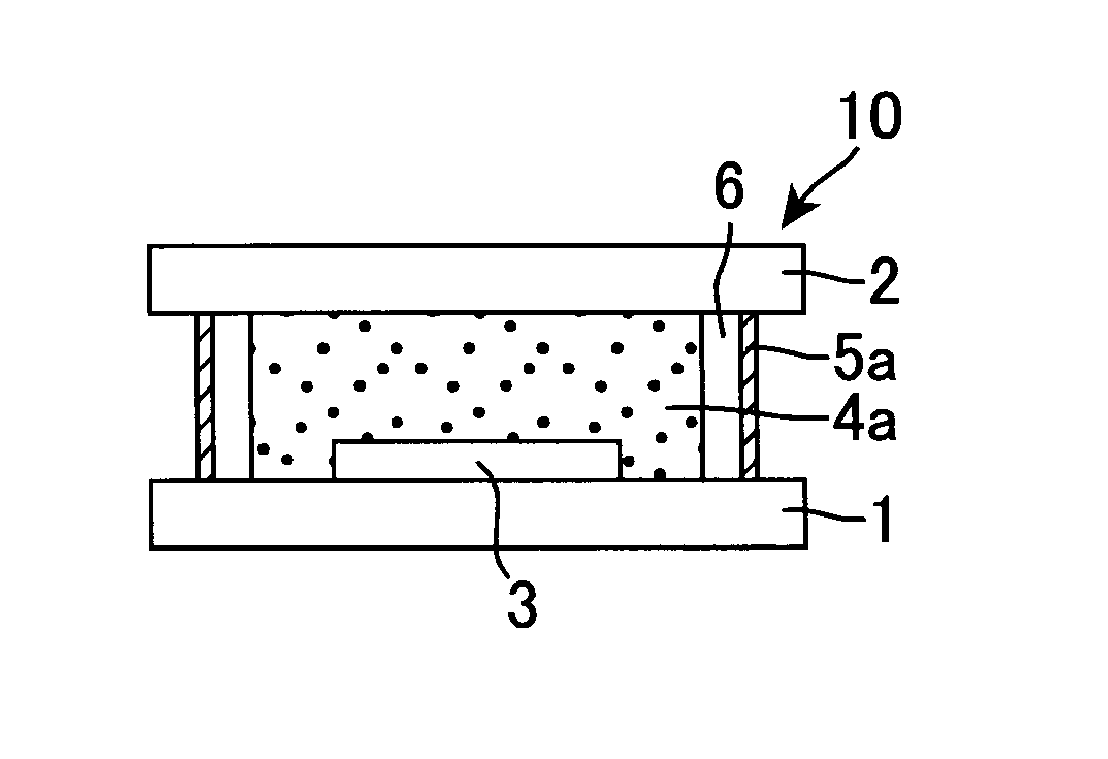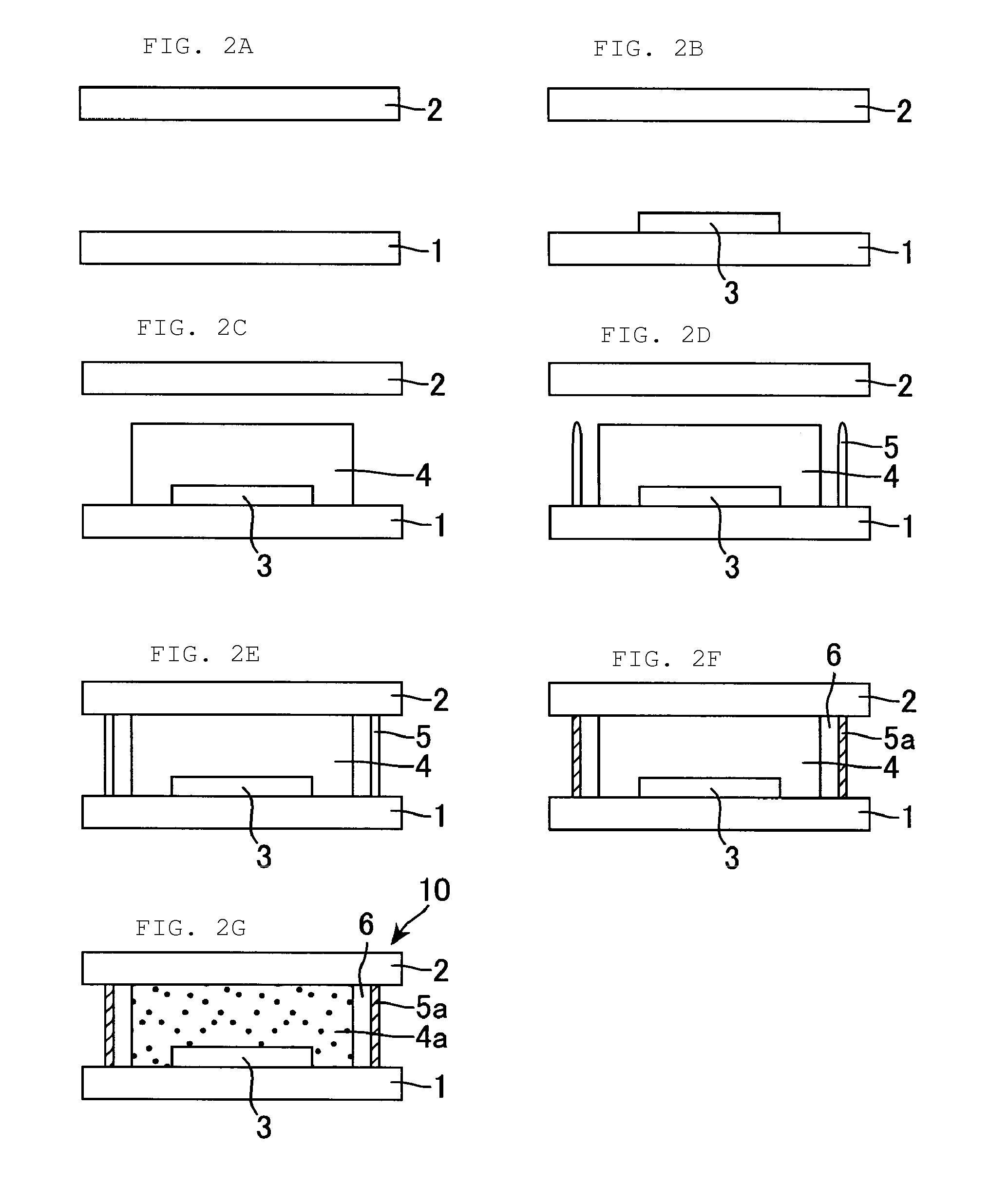Organic electroluminescent panel, organic electroluminescent display, organic electroluminescent lighting device, and production methods thereof
a technology of organic electroluminescent panels and lighting devices, applied in the manufacture of electrode systems, electric discharge tubes/lamps, discharge tubes luminescent screens, etc., can solve the problems of increased aperture ratio, difficult to provide, and reduced thickness of panels, so as to reduce heating time and simplify processes. , the effect of reducing the thickness
- Summary
- Abstract
- Description
- Claims
- Application Information
AI Technical Summary
Benefits of technology
Problems solved by technology
Method used
Image
Examples
embodiment 1
Preferred Embodiment 1
[0067]FIG. 1A is a cross-sectional view schematically showing a configuration of an organic EL panel in accordance with Preferred Embodiment 1. FIG. 1B is a schematic plan view thereof.
[0068]As shown in FIGS. 1A and 1B, an organic EL panel 10 in accordance with Preferred Embodiment 1 preferably includes: a flat element glass (element substrate) 1; a flat sealing glass (sealing substrate) 2 facing the element glass 1; an organic EL element 3 arranged on the sealing glass 2 side of the element glass 1; a cured product (the first sealing member) 5a of a liquid sealing member (airtight seal, liquid adhesive) arranged to seal a gap between the element glass 1 and the sealing glass 2; a cured product (the second sealing member) 4a of a solid sealing member that is arranged to cover the organic EL element 3 and that forms a vacuum or reduced pressure space 6 between itself and the cured product 5a of the liquid sealing member. In FIGS. 1A and 1B, only one organic EL e...
embodiment 2
Preferred Embodiment 2
[0096]FIGS. 3A to 3D are perspective views schematically showing production steps of an organic EL panel in accordance with Preferred Embodiment 2.
[0097]The sealing glass (sealing substrate) 2 is produced first, as shown in FIG. 3A.
[0098]Then, although not shown in FIG. 3A, a plurality of organic EL elements are arranged on the element glass (element substrate).
[0099]Then the solid sealing member 4 is arranged on the sealing glass 2 by roll-to-roll method, as shown in FIG. 3B (solid sealing member-arranging step). The solid sealing member 4 is arranged in such a way that it covers a plurality of organic EL elements 3 after the element glass 1 is attached to the sealing glass 2. Thus, the plurality of organic EL elements 3 are covered by a common solid sealing member 4, and thereby the takt time for the attachment of the solid sealing member 4 can be significantly shortened compared to the case that the organic EL elements 3 are each covered by different solid s...
embodiment 3
Preferred Embodiment 3
[0105]FIG. 5A is a cross-sectional view schematically showing a state that a liquid sealing member including spacers is arranged on an element glass. FIG. 5B is a cross-sectional view schematically showing a state that the glass substrate 1 is attached to the sealing glass 2 after the state shown in FIG. 5A.
[0106]The present Preferred Embodiment is preferably the same as Preferred Embodiment 1, except that the element glass 1 is attached to the sealing glass 2 as shown in FIG. 5B, after the liquid sealing member 5 including spherical spacers 7 is arranged on the element glass 1 as shown in FIG. 5A. The average particle size of the spacer 7 is preferably about 1 μm to about 100 μm, and it is more preferably about 20 μm or less, for example, in view of sealing performances and light transmittance. Thus, the spacers 7 are included in the liquid sealing member 5, and thereby, a gap between the element glass 1 and the sealing glass 2 can be kept constant. In this ca...
PUM
| Property | Measurement | Unit |
|---|---|---|
| thickness | aaaaa | aaaaa |
| light transmittance | aaaaa | aaaaa |
| pressure | aaaaa | aaaaa |
Abstract
Description
Claims
Application Information
 Login to View More
Login to View More - R&D
- Intellectual Property
- Life Sciences
- Materials
- Tech Scout
- Unparalleled Data Quality
- Higher Quality Content
- 60% Fewer Hallucinations
Browse by: Latest US Patents, China's latest patents, Technical Efficacy Thesaurus, Application Domain, Technology Topic, Popular Technical Reports.
© 2025 PatSnap. All rights reserved.Legal|Privacy policy|Modern Slavery Act Transparency Statement|Sitemap|About US| Contact US: help@patsnap.com



